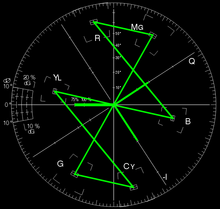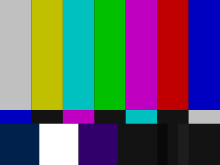- SMPTE color bars
-
"Color bar" redirects here. For the political issue, see racial segregation.
 SMPTE color bars look somewhat like this on an NTSC vectorscope.
SMPTE color bars look somewhat like this on an NTSC vectorscope.
The SMPTE color bars are a type of television test pattern, and is most commonly used in countries where the NTSC video standard is dominant, such as those in North America. The Society of Motion Picture and Television Engineers (SMPTE) refers to this test pattern as Engineering Guideline EG 1-1990. The components of this pattern are a known standard, so comparing this pattern as received to that known standard gives video engineers an indication how an NTSC video signal has been altered by recording or transmission, and thus what compensation needs to be applied to that signal to bring it back to original condition. The pattern is also used for setting a television monitor or receiver to reproduce NTSC chrominance and luminance information correctly. Originally conceived in the 1970s by Al Goldberg of CBS Laboratories, and previously categorized by SMPTE as ECR 1-1978, the development of this test pattern was awarded an Engineering Emmy in 2001-2002.[1]
An updated version of SMPTE color bars, developed by the Japanese Association of Radio Industry and Businesses as ARIB STD-B28 and standardized as SMPTE RP 219-2002, is used to test both 4×3 standard definition and 16×9 high-definition video signals.
Contents
Usage
In an SMPTE color bar image, the top two-thirds of the television picture contain seven vertical bars of 75% intensity. In order from left to right, the colors are gray, yellow, cyan, green, magenta, red, and blue. This sequence runs through all seven possible combinations that use at least one of the three basic color components of green, red, and blue, with blue cycling on and off between every bar, red cycling on and off every two bars, and green on for the leftmost four bars and off for the rightmost three. Because green contributes the largest share of luminance, followed by red, then blue, this sequence of bars thus appears on a waveform monitor in luminance mode as a downward staircase from left to right. The graticule of a vectorscope is etched with boxes showing the permissible regions where the traces from these seven bars are supposed to fall if the signal is properly adjusted.
Below the main set of seven bars is a strip of blue, magenta, cyan, and white castellations. When a television receiver is set to filter out all colors except for blue, these castellations, combined with the main set of color bars, are used to properly adjust the color controls; they appear as four solid blue bars, with no visible distinction between the bars and the castellations, if the color controls are properly adjusted.
The bottom section of the test pattern contains a square of saturated (100% intensity) white and a rectangle of saturated (7.5% intensity) black, for use in setting the luminance range. More modern versions of the pattern feature a "pluge pulse." The pluge (short for "Picture Line-Up Generation Equipment") pulse is positioned within the black rectangle, below the red bar (it is present in the illustration but may be hard to see). It comprises three small vertical bars, a rightmost one with intensity just above the saturated black level, a middle one with intensity exactly equal to saturated black, and a leftmost one with intensity just below saturated black (or "blacker than black"). The pluge pulse aids in adjusting the bottom of the luminance range to avoid either washing out the black tones into grays or collapsing picture information into the signal clipping that occurs a small distance below the saturated black level (known as "crushing the blacks"). When a monitor is properly adjusted, the rightmost pluge bar should be just barely visible, while the left two should appear completely black. Also in the bottom section are two sections that contain -Inphase and +Quadrature signals (see YIQ), centered on black level and having the same gain as the color burst signal; these show up on the pattern as a square of very dark blue, and a square of very dark purple. On a vectorscope, they appear as two short lines ninety degrees apart. These are used to ensure that the television receiver is properly demodulating the 3.58 MHz color subcarrier portion of the signal. The vectors for the -I and +Q blocks should fall exactly on the I and Q axes on the vectorscope if the chrominance signal is demodulated properly.
SMPTE color bars with 1kHz sine wave tone.
These bars give rise to the former portion of the casual term, "bars and tone". Typically, a television network, TV station, or other originator of video programming transmits SMPTE color bars together with a continuous 1000 Hz audio tone before sending program material, in order to assert ownership of the transmission line or medium, and so that receiving stations and intermediary telecommunications providers may adjust their equipment. Likewise, producers of television programs typically record "bars and tone" at the beginning of a videotape or other recording medium so that the playback equipment can be calibrated. Often, the name or callsign of the TV station, other information such as a real-time clock, or another signal source is graphically superimposed over the bars.
An alternate form of color bars is the 100% Color Bars pattern, or RGB pattern, which consists of eight vertical bars of 100% intensity, and does not include the castellation or luminance patterns. Like the SMPTE standard ("75%") pattern, the color order is white, yellow, cyan, green, magenta, red, and blue, but with an additional column of saturated black. This pattern is used to check peak color levels and color saturation as well as color alignment. The 100% pattern is not as common or as useful as the SMPTE standard 75% pattern, but many pieces of test equipment generate both patterns, and can be selected to generate either one. Many professional cameras can be set to generate a 100% pattern for calibration to broadcast or recording equipment, especially in a multi-camera installation where all camera signals must match. There is another 75% pattern that consists of the same eight columns as the 100% pattern, but at 75% intensity. This pattern is very seldom used.
Although color bars were designed to calibrate analog NTSC equipment, they remain widely used within modern digital television facilities. All display monitors use some form of voltage to illuminate or activate a level of opacity in a pixel. Using color bars allows video, RGB, LCD, and Plasma displays, as well as duplication, television and webcast facilities, to maintain the intended chroma and luminance levels.
In the 1970s and early 1980s, the color bars were often broadcast by local television stations during special "color check" segments. For example, CFQC-TV in Saskatoon, Saskatchewan preceded each nightly newscast with "Color Check", which began with the SMPTE color bars as an announcer identified the colors of the vertical bars encouraging viewers to adjust their TV color settings to make sure the colors were "well separated" and matched the description, after which a photograph (later video footage) of a woman's face was broadcast for a few moments, allowing viewers to adjust their TV color settings further.[citation needed]
See also
References
- ^ NATAS Engineering Awards Listing, and conversation with Hank Mahler of CBS, Emmy co-recipient.
External links
Standards SMPTE D10 · SMPTE D11 · SMPTE 259M · SMPTE 292M · SMPTE 344M · SMPTE 372M · SMPTE 424M · SMPTE color bars · SMPTE time codeRelated articles Related standards organizations National Television System Committee · Moving Picture Experts Group · Pro-MPEG · The ITU Radiocommunication Sector (formerly known as the CCIR) · BBC Research · European Broadcasting UnionStandard test items Television (test card) Computer programming Data compression 3D computer graphics Other Categories:- SMPTE standards
- Test cards
- Television terminology
Wikimedia Foundation. 2010.


